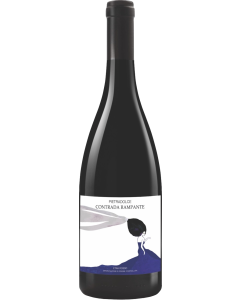
The world of Italian red wine can be challenging to navigate. There is a huge variety of delicious grapes, wine styles and regions to choose from, all with their own unique and lengthy names. With this guide, you can learn some of the most important names to look out for, and discover which wine suits you best. There is a bottle of red Italian wine for every occasion, from light and fruity delights to tannic powerhouses. We have broken it down for you, one region at a time.
Best Italian Red Wines by Region
Tuscany
Tuscany is possibly the most well-known region in the country, home to some of the best Italian red wine. It’s famous for its scenic landscape - rolling green hills lined with vineyards, clear blue skies, and red-roofed villages. Tuscany’s primary grape, Sangiovese, is expressed in many different ways. It thrives in Tuscany’s hotter inland regions, as well as its milder coastal areas. For a top-rated Tuscan red wine, it is difficult to do any better than Fontodi’s Flaccianello della Pieve. This is made in the unregulated Super Tuscan style but is 100% Sangiovese - bold, powerful and unbeatable, the ratings speak for themselves. If you are seeking something more affordable, try this Chianti Classico. It’s from a remarkably good winery and is a complex yet enjoyable Tuscan classic.
Sicily
Sicily is Italy’s southernmost region, home to a unique environment for grape-growing. It is distinctly Mediterranean, eternally sunny and with a dependable amount of rainfall, perfect for creating prime Italian red wine. Sicilian terroir is also influenced by Mount Etna and the island’s many volcanic hills, which help to form dark, mineral-rich soil. For great value, look for the label of Josue Terre Siciliane and their excellent Rosso lend. It combines the Sicilian grape Nero d’Avola with the French Cabernet Sauvignon, resulting in an elegant and fruity wine that has received a score of 98 and 99 from critics. You can also consider another top-rated red wine from the slopes of Mount Etna, the Etna Rosso, which is a full-bodied delight.
Lombardy
Lombardy is a large region in the heart of northern Italy. It cannot be limited to one style of wine - due to the variety of the region’s geography, it is home to a range of different climates and several red wine types. Despite being landlocked, the region is not overly hot due to the cooling effect of its many large lakes, Lake Como and Garda being two of the most famous. For an Italian red wine that combines outstanding reviews with a great price, take a look at this red blend from Ca dei Frati, Ronchedone. A combination of French and Italian grapes, Ronchedone is rich with flavour and an attractive deep scarlet.
Veneto
In Italy’s northeast, the region of Veneto produces more wine than any other region in the country. It is the birthplace of Prosecco, but as far as red wine goes, Veneto is famous for its Valpolicella, a blend of 3 native Italian red wine grapes, Corvina Veronese, Rondinella, and Molinara. Climate-wise, Veneto varies from alpine terroirs on the edge of the Alps to hotter and drier areas further south. Amarone della Valpolicella Classico is generally considered to be the best version of Valpolicella that you can get, they are rich, aromatic and delicious. If you’re looking to splurge on the best of the best, Quintarelli winery makes this amazing red wine, consistently rated 95+ and highly collectable. If you are on a lower budget and still want a taste of Veneto, try Opera No. 3 from Tinazzi. It is not a Valpolicella blend but is an enjoyable blend of 3 famous Italian grapes.
Sardinia
Off the west coast of Italy, Sardinia is an outlier from the rest of Italy. The region’s growers do not utilize typical Italian red wine grapes, and Sardinia as a whole is more influenced by French and Spanish wine culture. Only a small amount of land is given over to vineyards, but the island has great potential for future viticulture, with a huge variety of soils and sub-regions, and a Mediterranean climate ideal for creating good red wine. Both of our recommendations for Sardinia are expressions of Carignan, an underrated grape from the south of France. Both are reasonably priced, but this Assaje from Capichera winery has a slight advantage in terms of rating. It is full of plum, dark chocolate and spice. Meanwhile, Barrua from Agricole Punica is the other option, also rated extremely highly, and bursting with red fruits and herbs.
Piedmont
In the mountainous corridor between France and Switzerland, Piedmont’s climate is defined by the Alps and Apennines. The towering mountains create a favourable climate for grape-growing, leading to some of the most famous Italian red wine grapes, such as the highly acidic Nebbiolo. The distinguished Barolo red wine is produced from this fruit and is ranked among the top wines in the world. If you want to try it for yourself, we recommend the Barolo Reserva. It is excellent for ageing, and its intense sour cherry profile is highly prized - Barolo is an experience in itself. For another Piedmont classic that can be enjoyed with some food, try a Barbera. La Spinetta makes this Barbera d’Asti Ca di Pian, which still has a distinctive cherry profile, but is slightly less challenging than a tannic Nebbiolo wine.
Abruzzo
On Italy’s eastern coast lies the region of Abruzzo, home to some truly excellent and regionally native Italian red wines. Abruzzo can be distinguished by how mountainous it is, the majority of grapes are grown among its many hills at a relatively high altitude. The warm Adriatic sea also offers generally dry and warm terroirs. It is well-known for Montepulciano, another one of Italy’s famous red wines, and well worth diving into. Mascarielli winery create a top class iteration of the grape, Montepulciano d'Abruzzo Riserva. It is an archetypal Montepulciano, complex with soft dark berry flavours. Torre dei Beati also produce a Mazzamurello Montepulciano d'Abruzzo, which is a fantastic bargain with several 93+ ratings. Montepulciano is one of Italy’s most exported wines and is famous for pairing well with pizza.
Puglia
Puglia is in Italy’s deep south, making up the heel of the country’s boot. The stereotypical image of Puglia is one of flat, scorched fields, and almost oppressive sunshine. It is the least mountainous region of Italy and Puglia’s most famous grapes, such as Primitivo and Negroamaro, are largely found on the southern tip of the peninsula. The region's climate is wholly Mediterranean and extremely warm, and its soils tend to be rich in limestone. Italian red wines from this region tend to match the landscape - they are noticeably powerful, fiery, and deep in colour. San Marzano produces an intense Primitivo Di Manduria of great value, from vines grown on vivid red soil. For a top-shelf experience, try another Primitivo from Manduria, produced by Attanasio, a very good boutique winery in Southern Italy. It combines the boldness of a stereotypical Primitivo with remarkable smoothness.
Friuli
One of several regions located in Italy’s northeast pocket, the region of Friuli borders Austria and Slovenia. Friuli is dominated by white wines but is also home to some lesser-known Italian red wine grapes that are native to the region. In terms of terroir, Friuli ranges from the cooler continental climate in the Alpine foothills, to the warmer Mediterranean as it approaches the Adriatic Sea. Despite the slightly cooler climate here in the north, Friuli’s grapes can be extremely tannic. You can try a taste of Friuli’s native red wine grape of Pignolo: Eldoro. It contains some extremely ripe flavours and is a great 90+ rated example of Italy’s more niche red wines.
Trentino-Alto Adige
In Italy’s furthest north, at the Austrian border, the two autonomous regions of Trentino and Alto Adige make one distinct wine region. It is famous for its white wines, but French grapes are being grown here more and more frequently, introducing some brilliant Bordeaux blends to the world of Italian red wine. Trentino-Alto Adige’s terroir is right for it, as the floors of the Alpine valleys have an unusual warming effect, producing surprisingly bold red wines from a generally cool climate. To try a rich blend of Merlot, Cabernet Sauvignon, and the native Trentino grape Lagrein, try this Reserve del Conte from Manincor winery. For a top-rated expression of Bordeaux grapes grown in Italian terroir, we recommend this Anticus Riserva, an elegant red with notes of blackcurrant and spice.
Questions we frequently get about Italian red wines
-
What are the three most popular Italian red wine grapes?
Sangiovese is by far the most popular and widespread red wine varietal in Italy - Chianti, Brunello and Rosso di Montalcino are all made from this grape, and it is frequently used in blends. Primitivo is a close second, largely grown in Southern Italy. It is famously potent, giving rise to full-bodied and powerful wines with an international reputation such as Primitivo Di Manduria. Finally, Nebbiolo, which is native to the Piedmont region, produces popular Italian wines with notes of tar and roses. These include the mighty and extremely high-quality Barolo, and the slightly less tannic Barbaresco.
-
What are the main differences between Italian and French red wine profiles?
Italian red wine can be stereotyped as generally bold, acidic and tannic, while French red wines may have slightly smoother tastes and are lighter-bodied. This is due to geography and differences in wine-making methods - France is further north, with less influence from the Mediterranean climate, and so has less capacity for producing robust, full-bodied grapes like Primitivo. However, the differences between Italian and French red wines are subtle, and can only be spoken about generally, as each wine-making region in either country has its distinct style and grapes.
-
Which of the most popular Italian red wines are traditional and which ones are relatively new to the scene?
The majority of the popular Italian red wine types have deep roots in Italian culture and a great deal of history behind them. Primitivo can be considered the newest, it was likely introduced to Puglia from Croatia in the 18th century. Wines bearing the name “Super Tuscan” are also relatively new to Italy, originating in the 1970s, as are any popular red wine blends that use international grape varieties.
-
How many main types of Italian wine are there?
Italian red wine can be categorised in many different ways. There is an endless amount of native grapes, which are used to produce even more wine styles. For example, the Sangiovese grape is used to make both Chianti and Brunello, which can both be considered major Italian wines, even though they are remarkably different. For simplicity, the major Italian red wine grapes can be limited to 8, some of which are used to produce more than one style of wine. Sangiovese (to make Chianti and Brunello), Primitivo (for Primitivo Di Manduria and Falerno), Nebbiolo (used to produce Barolo and Barbaresco), Montepulciano, Barbera (for Barbera D’Asti and Nizza), Nero d’Avola, Valpolicella Blends (made from several lesser known grapes), and Dolcetto.
-
What is the most famous wine in Italy?
Barolo is considered by many to be the most prestigious Italian red wine. It is ranked alongside the best of Bordeaux’s reds, wines from Rioja, and Burgundian Pinot Noirs. Barolo is high in tannins and acidity, full-bodied, and well known for its bouquet of tar and roses.
-
What are the best value Italian red wines?
Some of the best Italian red wines that combine high ratings and quality with an affordable price are this Rosso from Josue Terre Siciliane which was rated 99 by Luca Maroni, these Valpolicella blends from Luciano Arduini and Tinazzi winery, or this classic Brunello Di Montalcino made by Castiglion del Bosco winery.
-
What is a good Italian red wine to give as a gift?
This depends on what sort of gift you want to give - an age-worthy red wine, something that can be enjoyed straight away, or perhaps something with a beautiful wine bottle. For an age-worthy Italian red, you can’t do better than a Barolo or Barbaresco - we recommend this collectable Barolo from Piedmont, it’s a bottle than can gather some dust before being enjoyed. For an Italian wine that can be enjoyed immediately, Montepulciano d’Abruzzo is the answer - it goes well with pizza, and tasting cases are also available online. A beautiful bottle comes down to personal taste - it’s easy to find something funky, something tall and elegant, or something classic.
Hopefully, this guide has helped to demystify the world of Italian red wine for you. Although some wines are more highly regarded than others, it all comes down to personal taste. The only thing left to do is start tasting!






























communication en speed ol service